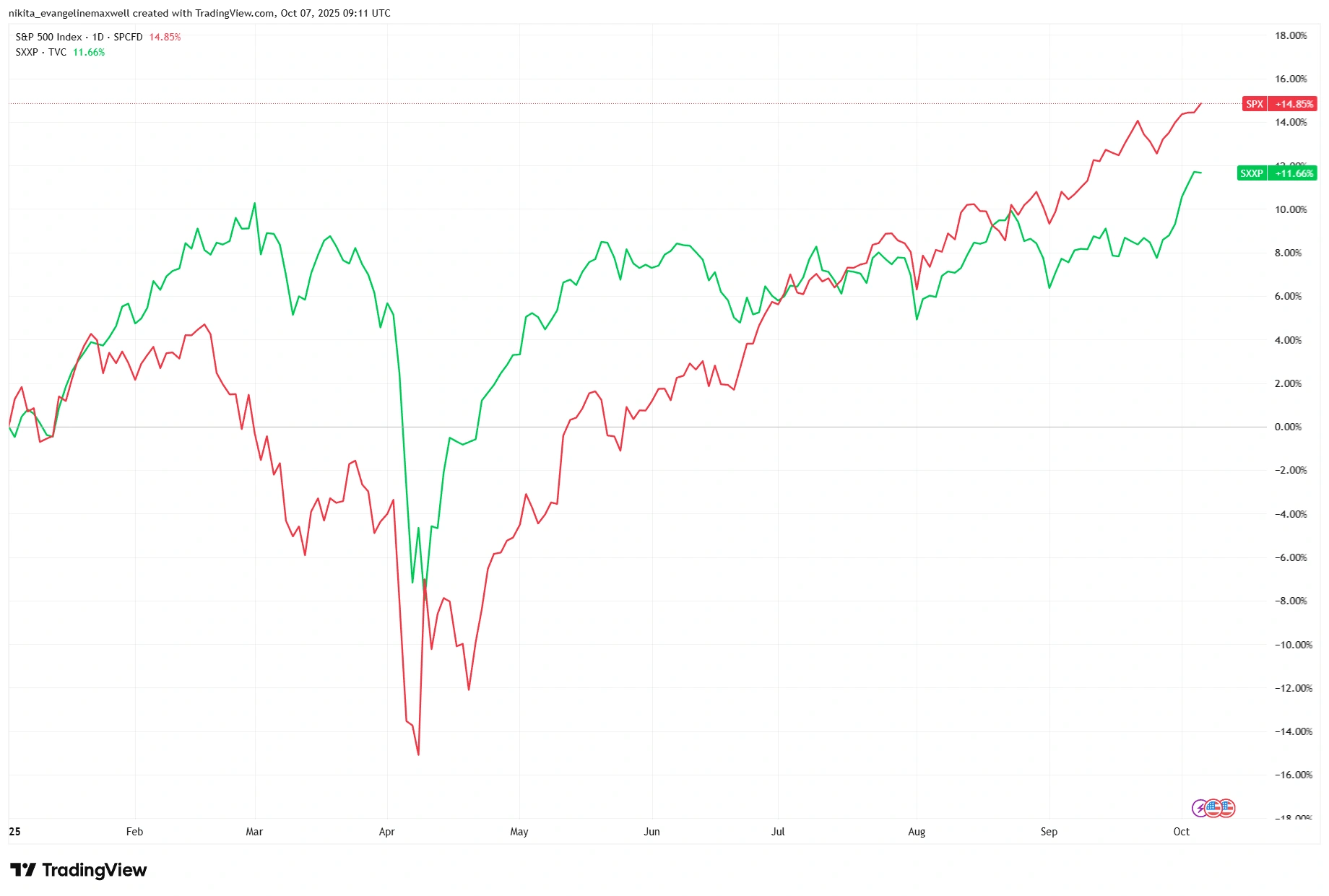Ações dos EUA vs Europa: quem está liderando o rali pós-corte de juros?
After two long years of rate hikes, the pendulum has finally swung the other way. Both the Fed and ECB have started cutting interest rates, easing financial conditions that had been tightening since 2022. But here’s the twist, markets on both the sides aren’t reacting the same way.
The US looks pricey, while Europe still trades at a heavy discount. The S&P 500 sits near 22× forward earnings, close to its most expensive levels, while the STOXX 600 trades closer to 13-15×, one of the widest valuation gaps in decades. Naturally, investors are asking the big question: as policy loosens, who has more upside – the US or Europe?
For years, global funds have been heavily overweight the US and underweight Europe. But that’s beginning to shift. As rate cuts kicked in, mid-2025 surveys showed fund managers tilting back toward Europe and cutting down US exposure. Whether that proves temporary or a lasting rotation remains to be seen.
Key Drivers
The Fed and ECB may both be easing, but not at the same pace. Markets expect roughly 150 bps of Fed cuts by late 2025, far more than the ECB is signalling. That’s fuelling a different tone in each region. In the US, investors are cheering cheaper money and a tech-led rally, while Europe’s slower cuts are keeping optimism more muted.
US equities trade at near-record premiums; Europe remains historically cheap. Paying twice as much for every dollar of earnings in the US versus Europe doesn’t sit well with some investors. That discount is luring bargain-hunters who think Europe could finally play catch-up if growth stabilises.
The US market is tech-heavy, with technology now around one-third of the S&P 500’s weight. So when rates fall, Big Tech rallies first. Europe, meanwhile, leans on banks, industrials, and luxury – more “real economy” than “digital boom.” That means the US races ahead in a growth-driven rally, but Europe shines when value and cyclicals come back into fashion.
Investor positioning tells the same story. Early 2025 saw inflows into European equity funds as global investors rotated away from pricey US names. But with US tech roaring again, some of that money has flowed back. For now, capital keeps oscillating between the two regions.
YTD 2025: US vs European Equity Performance

Source: TradingView. All indices are total return in US dollars. Past performance is not a reliable indicator of future performance. Data as of 7 October 2025.
Since rate cuts began, US equities have extended gains, while Europe’s recovery remains steadier but slower.
Fundamentals: Valuations, Earnings & Balance Sheets
Put simply, US stocks are expensive because expectations are high, while Europe’s cheaper valuations reflect doubt – but also potential. The S&P 500 trades at 22× forward earnings, versus 13–15× in Europe. That means US companies need to deliver near-perfect results to justify their price tags, whereas Europe only needs “less bad” news to surprise on the upside.
Earnings help explain the gap. Analysts expect US corporate profits to grow roughly 15% in 2025, powered by tech and resilient consumers. Europe’s earnings growth is slower, around 10%, but improving from last year’s slump. In other words, Europe’s catching up but just not flashy enough.
Then there’s how companies reward shareholders. US firms love buybacks. More than $1 trillion of buybacks were announced in 2024, while Europe prefers dividends, offering higher yields instead. Culturally, it’s different: Americans boost earnings-per-share through repurchases; Europeans hand investors steady income. Both approaches appeal, depending on what you’re after (either growth or yield).
Financially, both regions are in decent shape. US balance sheets carry more debt but also more cash. European firms are generally more conservative, which may cap upside in booms but offers resilience in downturns. In essence, the US is priced for perfection, while Europe’s lower bar gives it more room to surprise.
Macro Tailwinds & Headwinds
Cooling inflation has eased pressure on central banks, giving them room to cut rates without reigniting price spikes. The ECB has already trimmed rates three times, bringing its deposit rate to 2.0%. Liquidity is improving, credit conditions are loosening, and markets finally have a tailwind instead of a headwind.
The stronger euro, that is up roughly 10-15% against the dollar in 2025, has also helped European assets, boosting returns for dollar-based investors. Meanwhile, global manufacturing is slowly recovering, lifting Europe’s export-driven sectors. Add it all up, and the macro backdrop is more supportive than it’s been in years.
Still, risks linger. Inflation could prove sticky, forcing the Fed or ECB to pause cuts. Europe’s growth remains sluggish, hovering near zero, and if China’s rebound stalls, its exporters will feel it. In the US, valuations are vulnerable. If the AI boom loses steam or profit margins tighten, the market could wobble. And geopolitics never sleeps: tariffs, elections, or currency swings could quickly change the tone.
Final Takeaway
Both regions tell compelling but contrasting stories. The US has the growth engines and investor confidence, but it’s priced for perfection. Europe has value, dividends, and plenty of room to catch up if sentiment improves.
The US is sprinting ahead but expensively; Europe is slower but more affordable. The baton could pass either way depending on earnings and capital flows. For now, Wall Street’s still leading, but Europe’s discount makes it hard to ignore. In a world where rate cuts are back and recession fears are fading, it might just pay to keep a foot in both camps, because the jury’s still out on who wins the next leg of this rally.